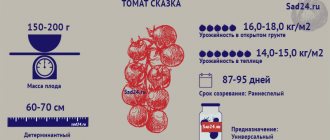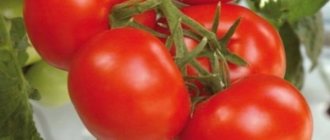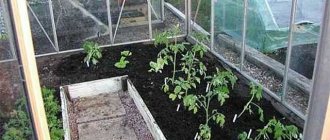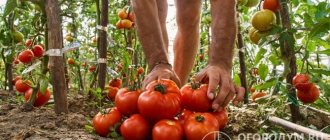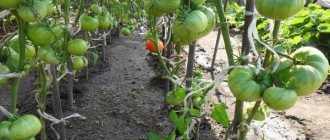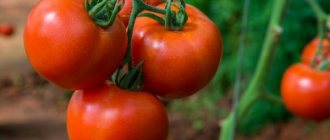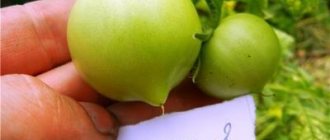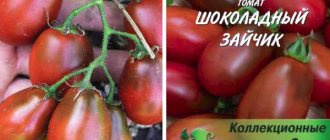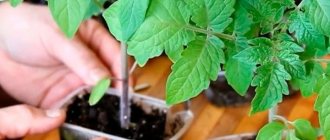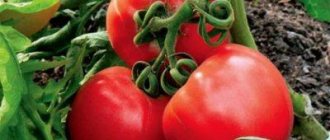Pros and cons of the variety
The positive aspects of the Countryman tomato include:
- Good transportability of tomatoes;
- Versatility of use;
- Easy to care for;
- Formation of a sufficient number of seeds;
- Early and friendly maturation;
- Low bushes;
- There is no need to form a bush.
This variety has practically no disadvantages. These include only demands on soil and watering.
Important! Tomato Countryman should be watered only after the top layer of soil has dried. When growing the Zemlyak variety, getting an excellent tomato harvest is not difficult.
It will delight experienced gardeners with its unpretentiousness, and beginners can easily grow a lot of beautiful fruits. Compliance with the minimum requirements for caring for the Countryman tomatoes, as described, will allow you to enjoy delicious tomatoes from your plot in July
When growing the Zemlyak variety, getting an excellent harvest of tomatoes is not difficult. It will delight experienced gardeners with its unpretentiousness, and beginners can easily grow a lot of beautiful fruits. Compliance with the minimum requirements for caring for Zemlyak tomatoes, as described, will allow you to enjoy delicious tomatoes from your plot in July.
Feeding tomatoes
It is recommended to fertilize tomatoes of this variety throughout the entire growing season of tomato bushes. To develop a full-fledged root system, it is necessary to provide for the application of phosphorus-containing fertilizers.
Tomatoes also require nitrogen and potassium. But if the root system is not developed, then the absorption of nitrogen-containing and potassium fertilizers will not be intensive enough.
Those who planted tomatoes noticed that a lack of phosphorus in the soil can be indicated by curling of the leaves, the appearance of dark spots on their underside, as well as slow ripening of the tomato. Even during the period of planting seedlings, ash or compost, containing a large amount of microelements necessary for the plant, is added to the holes. After planting, watering is carried out with a herbal decoction of chamomile, plantain or nettle.
According to reviews, for “Neighbor's Envy f1” tomatoes, it is optimal to fertilize with complex fertilizers, including nitrogen, potassium and phosphorus every 2 weeks. Their quantity should be regulated depending on the quality of the soil, as well as the condition of the plant. This will help you get maximum yield.
Best reviews from our readers
- Good afternoon I had a bit of an incident with a tomato called Neighborhood Envy. In 2021, I planted it and several other varieties, among which was Alhambra F1 from Johnsons. It turned out that the appearance, shape of the brushes and fruits and the yield are absolutely THE SAME! And later I bought the seeds of Neighbor’s Envy from another company, and there’s even the SAME photo on the bag, only in a mirror image. So what is this - plagiarism? Unfortunately, there are no photos. But I'll look for the bags.
- I planted it for the first time, but it’s already clear that the Neighbor’s Envy tomato is extraordinary. So many brushes on one bush and each with at least 10 tomatoes. You enter the greenhouse and your heart skips a beat with joy that I now have such a miracle.
- I planted the “Neighbor’s Envy” tomato for two years, the result exceeded all my expectations, there were a lot of fruits on the bushes, all even, beautiful, ripened quickly, and tasty. But the trouble is that for the third year now I cannot find the seeds of this tomato on sale.
7 809
Characteristics and description of the variety
Often, when preparing bags of tomato seeds from the “Raspberry Miracle” series, seed producing companies put the mark f1 on the packaging next to the name of the variety, which means this is a hybrid. Often, manufacturers are disingenuous so that summer residents do not dare to collect seeds of the variety they like, but come to buy them in stores at the beginning of each season. Many Raspberry Miracle tomatoes are varietal and not hybrid, so their seeds can be collected from ripened fruits and later used for cultivation.
Vegetable growers on forums share their impressions of growing different varieties and hybrids of the “Raspberry Miracle” line, talking about their most favorite ones:
- Tomato Golden Raspberry Miracle characteristics and description of the variety should begin with a story about the timing of ripening - this tomato belongs to the late-ripening species; from the moment of germination to the ripening of the fruit, about 5 months pass. The bushes are an indeterminate species, so their shoots can grow upward almost indefinitely. If the shoots are not pinched, their height can reach 1.9-2.1 m. These bushes require the obligatory formation of 2-3 stems, pinching the tops and tying them to strong supports. During breeding work, this variety showed high resistance to late blight, therefore, at late stages of fruit ripening, even the initial signs of late blight do not appear on these bushes. They are grown not only in open ground, but also in greenhouse conditions;
- The Yagoda-Malina tomato was bred by specialists from NPO “Garden and Vegetable Garden” LLC (this NPO is responsible for the breeding of a number of other Raspberry tomatoes), and was entered into the State Register in 2015. Tomato Berry Raspberry characteristics and description of the variety: ripe fruits are intended for fresh consumption and making salads. The bushes are low (55-60 cm in height), the shoots are strong, medium leafy, the foliage is dark emerald, typically tomato. The fruits in appearance are not very reminiscent of raspberries - very large, round, fleshy, of medium density, with a smooth, dense skin of a rich crimson color. The taste is pleasant sweetish-sour. Each fruit has 6 chambers with seeds;
- Tomato Raspberry Dawn is a mid-season variety. The shape of ripe fruits is heart-shaped, with smooth dark crimson skin. The weight of a ripe tomato is up to 400 g. The yield is simply enormous. The pulp is pinkish with a pleasant aroma and sweet taste. The fruits are consumed fresh and are also used in salads.
Other varieties of the raspberry series include:
- tomato “Raspberry Joy”;
- tomato “Raspberry Sunset”;
- variety "Raspberry Bogatyr".
Important! Seeds of any of these varieties can be bought in specialized stores or ordered online
Container and soil
At the next stage, prepare the container and soil. The soil is made up of garden soil, peat, humus and river sand.
Peat enriches the soil with useful substances necessary for the full development of seedlings, and sand acts as a leavening agent.
After thoroughly mixing the components, the resulting soil mixture is spilled with a hot solution of dark-colored potassium permanganate. Disinfection is necessary to destroy pathogenic flora, which can have a detrimental effect on seedlings.
Before sowing, containers are also disinfected with a manganese solution. You can plant them in a common wooden box or in separate containers. Do not forget that when planting seeds in peat containers, picking and replanting the seedlings is not required in the future. Peat cups decompose in the ground on their own and feed the young roots with useful substances.
Reference. Peat cups are the most convenient, but most expensive way to grow seedlings.
At the bottom of the planting containers, small holes must be made that perform a drainage function. Without the drainage of excess moisture, the likelihood of developing blackleg, a dangerous disease during the seedling period, increases. It can destroy all plantings. Characterized by darkening and narrowing of the stem at the bottom.
Non-grafting tomato characteristics and description of the variety
Let's look at the Nepas tomato characteristics and description of the variety.
The frost resistance of this crop is good, the variety is unpretentious, withstands temperature changes, and grows well both in open ground and in greenhouses. Due to its rapid ripening, the Nepas tomato is popular in regions with cool climates.
Nepas tomatoes
Important! Fruiting of this crop is quite fast, occurring within 85-100 days. The bush is quite low, stocky, the growth of the plant stops with the beginning of the formation of inflorescences. Does not require a garter, each brush can simultaneously support up to 6-7 fruits, weighing up to 100-300 g
Does not require a garter, each brush can simultaneously support up to 6-7 fruits, weighing up to 100-300 g.
Nepas tomatoes are suitable for consumption, both fresh and in the form of tomato paste, canned or pickled.
Fleshy, not watery, strong fruits have long established themselves as a tasty and unpretentious variety. The variety is resistant to various diseases, late blight and bacteria.
Variety of varieties Nepas
The Nepas tomato is divided into varieties popular in the middle zone:
Tomato non-sapling Orange with a spout or amber. This variety has become famous and is loved by gardeners for its unpretentiousness. The tomato can withstand temperature changes and can ripen in any dry or rainy summer. The Orange bush is small, stocky, stable. Contains beta-carotene. Popular among gardeners for the sweet taste of the fruit. The fruits of this tomato variety are characterized by a bright orange color, they are round with a spout at the end;
The red non-grafting variety is most popular in the Urals. It is the founder of the Nepas variety; the fruits are red in color and round in shape, convenient for pickling due to their uniformity and resistance to cracking;
Non-vining varieties of tomatoes for open ground. Perhaps the most original in appearance is the non-striped Striped. The fruits are a small crimson oval with yellow stripes; their decorative appearance and excellent taste are no less popular among gardeners. It is characterized by early ripeness and is suitable for both growing in greenhouses and for planting in open ground;
Non-grazing Sugar, got its name for its taste and high yield. Plum-shaped fruits. The tomato pulp is sweet and juicy, the plant can grow up to 90 cm in height;
Tomato Raspberry non-sapling or Pink are distinguished by the shade of the skin of the fruit; it is bright pink or raspberry-pink. The tomato is large, reaches a weight of 120-140 g. The fruits of the variety ripen together, the skin of the fruit is strong, suitable for storage and long-term transportation.
Farmer reviews
Gardeners who have planted the Neighbor's Envy tomato in their beds confidently recommend it to other gardeners. Many experienced summer residents harvest twice during the summer, since the early ripening periods allow time to grow the second wave in the greenhouse.
Alexandra, Taganrog: “The neighbor’s Envy grew the tomato in the same way as other similar crops: tied, pinched, fertilized. The result was excellent. The fruits are large, juicy, delicious, and simply lick your fingers. I made a lot of preparations and still have some left over for fresh dishes. In a word, all the neighbors are the envy of them.”
Svetlana, Krasnodar: “I planted it for the first time, but it is already clear that the hybrid is extraordinary. There are at least 10 tomatoes on each cluster, and there are a lot of fruiting clusters on the seedling! All fruits are smooth, identical, beautiful. I go into the greenhouse, and my heart skips a beat with joy that I have such a miracle.”
Alexandra, Taganrog, 48 years old: “The year before last I planted Neighbor’s Envy tomatoes.” I purchased the seeds online. I planted it in a small greenhouse next to the house. I grew them in the same way as other similar tomatoes: tied them, pinched them, fertilized them. But the result was excellent. The neighbors also wanted to grow this variety on their property.
Vera, Belebey
Irina, Bogorodsk
Tamara, Ufa
Love, Kursk
source
source
Key Features
Vegetables are characterized by excellent transportability over long distances without losing their attractive appearance and a very pleasant taste. The hybrid steadfastly tolerates diseases such as cladosporiosis and fusarium, and is also very rarely infected with stolbur.
Early ripening tomatoes. This variety is determinate and is also characterized by an abundance of foliage. The growing season is approximately 100 days. First, inflorescences are formed after 5-7 leaves, and then after 1-2 leaves. The fruits have many chambers and their structure is dense. Unripe tomatoes are colored a uniform light green color, and ripe ones have a glossy bright pink surface; vegetables reach a weight of 180-250 g.
Tomato Persianovsky seeds
The shape of the fruit can be round or round-flat.
Note! Yield figures are around 17 kg/m2 in spring greenhouses, with the early harvest accounting for 30% of the total. In open ground, when irrigated with the addition of water-soluble mineral fertilizers, the yield is 60t/ha. In open ground, when organizing irrigation with the addition of water-soluble mineral fertilizers, the yield is 60t/ha
In open ground, when irrigated with the addition of water-soluble mineral fertilizers, the yield is 60t/ha.
These vegetables are grown for fresh consumption and long-distance transportation.
Usually the choice of pink tomatoes is very small and is limited to a few varieties of old selection and a few modern hybrids. The development of commercial hybrids is complicated by the fact that such varieties are subject to a rather impressive list of requirements. It is necessary to combine excellent taste and high content of nutrients; the fruits should be large and low in fiber.
They are characterized by resistance to mechanical damage and cracking of the skin, and an appetizing appearance.
Note! These tomatoes have a long shelf life, they tolerate transportation well, and are also immune to many diseases and adapt well to any conditions. Persianovsky is a bright representative of hybrids that produce excellent quality harvests even in regions with an unstable climate. Persianovsky is a prominent representative of hybrids that produce excellent quality harvests even in regions with an unstable climate
Persianovsky is a prominent representative of hybrids that produce excellent quality harvests even in regions with an unstable climate.
Features of agricultural technology
Today, breeders pay special attention to creating carpal hybrids. Previously, we grew tomatoes collected in bunches, but they only looked beautiful on a bush. Their ripening occurred unevenly, by the time the lower tomatoes turned red, the upper ones had long been picked - if we had left them, they would either have fallen to the ground or become soft and rotted. And how I would like to pick a beautiful bunch consisting entirely of red juicy fruits.
Modern cluster tomatoes are different:
- Friendly ripening of fruits. When the bottom one ripens, the top one still hangs on the hand and retains high taste and commercial characteristics. Tomatoes can stay on the bush for a month without overripening.
- Strong attachment of tomatoes. We pick them with a brush, move them, shake them. If they need to go on sale, we transport them, sometimes over long distances. They should stick well to the stalk.
- Uniformity in size - if the tomatoes are “different sizes”, they will look worse and cost accordingly less.
- The absence of a crease in the hand, which happens especially often in greenhouses due to the weight of the fruit - after a crease is formed, the fruit simply will not fill;
- High resistance to fruit cracking.
About
Characteristics of the variety
Tomato Irishka F1 is an ultra-early ripening variety, because the fruits ripen 3 months after sowing the seeds for seedlings. Even beginners can grow this variety, because the low bush does not require pinching and bush formation. And this is the most common problem among novice gardeners.
Description of the bush
The hybrid bush is not tall - about 50-60 cm. The peculiarity of the plant is the low foliage of the bush, which favors free access of air to the plant stem and prevents diseases. The plant is spreading due to its stepsons. According to the description, the tomato leaf is medium sized.
Description of fruits
Tomatoes Irishka F1 are smooth, small, red in color with a slight silver tint. Average weight is about 100-120 g. The skin of tomatoes is strong, which allows them to be stored for up to 2 weeks in a cool place. After ripening, they can hang on the bush for several days without cracking.
Productivity
The yield of the hybrid Irishka F1 depends on the composition of the soil. With well-processed and fertilized soil, you can harvest up to 3 kg of tomatoes per bush. This is an excellent yield indicator for determinate plants. On average, you can plant 5-6 bushes per 1 m² and, with good care, harvest up to 15-17 kg of fruit from them.
Resistance to diseases and pests
Because This variety is intended for open ground; it is exposed to precipitation (rain and morning dew), which provokes a fungal disease such as late blight. Due to high humidity during cyclone periods, tomatoes begin to turn black and rot.
Therefore, the prevention of fungal diseases is important - do not allow water to stagnate in the soil, constantly inspect the plants and, at the first signs of illness, spray them with fungicidal preparations. If the plant cannot be saved, it is better to remove it so as not to infect its “neighbors”.
Preventive measures will keep plants healthy
Pests can also threaten tomatoes: spider mites, aphids, thrips, and Colorado potato beetles. To protect against them, the bush can be treated with Fitoverm or a soap solution in the evening.
Application of fruits
Irishka tomatoes are universal in use. They are suitable for salads. The sweet-sour taste adds a piquant note to ketchups, juices, and purees.
According to the characteristics of the variety, harvested tomatoes can be stored in the refrigerator for up to 2 weeks or in a cardboard box in a cool basement. Due to the thick skin, the fruits tolerate transportation and storage well.
Growing regions
Kharkov breeders bred this variety for cultivation in the North Caucasus in open ground. This tomato tolerates heat and even drought, as well as exposure to direct sunlight. But gardeners grow this tomato in central Russia in greenhouses. And under these conditions, culture showed itself perfectly.
General characteristics of tomato
The fruits are round in shape, with flattened upper and lower parts. After ripening they turn red. The taste of the tomatoes is quite pleasant for a hybrid variety. The weight of one tomato can reach 110 g. The total weight of the harvested crop per square meter is 17 kg.
Growing in a greenhouse method has a number of advantages:
- In a greenhouse, it is possible to quickly cope with plant damage from pests and diseases.
- Weather conditions have virtually no effect on the process of growing tomatoes.
- Possibility of obtaining two harvests per year.
- In conditions of a heifer, it is easier to care for tomatoes of an indeterminate variety, as well as carry out the procedure of tying them to a trellis.
The tomato variety “Neighbor's Envy”, as well as other raceme varieties, have the following features:
- the fruits ripen at the same time and can remain in a ripened state on the bush for a month without losing their presentation;
- tomatoes are firmly attached to the cyst and do not fall apart even during transportation;
- the fruits are almost the same size;
- the stems do not tend to form creases, ensuring fruit ripening;
- The dense peel is not prone to cracking.
These fruits have a wide range of uses. They are added to fresh vegetable salads, canned, and produced juices. The small size allows you to preserve them whole. The hybrid has a positive characteristic - the ability to resist typical diseases of vegetables of this type.
About
Planting and care
Seeds are planted for seedlings in late March or early April. Since this is a hybrid, the seed is purchased from the manufacturer, who has already treated it for bacteria and fungi, so disinfection is not required. But it is recommended to soak the seeds in a solution of a growth stimulant, for example, “Zircon” or “Epin” or a home remedy: 1 tsp. honey per glass of water.
The soil is taken ready for tomatoes and peppers or mixed with garden soil, peat and river sand with the addition of wood ash. At a distance of 3 cm from each other, grooves are made with a depth of 1 cm, the seeds are sprinkled with a layer of soil, sprayed with water from a spray bottle, covered with film and placed in a warm place with a temperature of +23-25 degrees. Every day the film is raised for 15-20 minutes for ventilation.
When sprouts appear, the covering is removed, the temperature is lowered to +20 degrees, and the boxes are transferred to a well-lit windowsill. They are turned daily. They dive after the development of 1-2 leaves.
They can be planted in a greenhouse in May, in open ground in June. The planting pattern is 30 by 50 cm. Compost or wood ash is placed in the holes.
Water the bushes with settled water at the roots, preferably in the evenings.
They are fed with preparations containing nitrogen, phosphorus and potassium. To regulate fertilizing, look at what kind of leaves the tomatoes have. A normal leaf is smooth, dark green in color, similar in shape to a potato. If it curls and becomes covered with dark spots, this is the first symptom of phosphorus deficiency.
Nitrogen is added 10-14 days after planting the seedlings, and phosphorus and potassium are added with the beginning of fruit ripening. Humus, complex mineral fertilizers, and watering with home remedies - decoctions of nettle, plantain or chamomile - are suitable.
To prevent diseases, bushes are sprayed with “Fitosporin” and the watering regime is observed; the soil is mulched to maintain normal humidity.
How to grow tomato seedlings yourself
This hybrid requires a seedling method of cultivation, so the first condition for a good harvest is high-quality seeds from the manufacturer. To sow seedlings, it is necessary to select the right soil mixture and create favorable conditions for growth.
Did you know? One of the main differences between a hybrid and a variety is the impossibility of sowing self-collected seeds. On the packaging the hybrid is designated by the code “F1”.
Optimal timing for sowing
The sowing time depends on the growing region, as well as the possibility of additional lighting to increase daylight hours. Most often, seedlings begin to be prepared in early or mid-March. From sowing to planting in a permanent place, 60–65 days should pass.
The soil
To grow tomato seedlings, it is recommended to mix garden soil, peat, rotted sawdust and humus in equal parts. Nutrient components are added to a bucket of this composition:
- 1.5 cups of ash;
- 3 tbsp. l. superphosphate;
- 1 tbsp. l. potassium sulfate;
- 1 tsp. urea.
Ordinary soil must be cleared of roots, stones and debris. Soil with a high clay content is not suitable for seedlings. To avoid possible contamination of plants, garden soil must be disinfected. To do this, one of the following events is carried out:
- the container or bag with soil is frozen at -15 °C, then thawed for 3–5 days and this process is repeated 2–3 times;
- the soil is steamed over boiling water for 7–8 minutes;
- calcine the soil at +70–90 °C in the oven for 30 minutes;
- spilled with a solution of potassium permanganate.
You can also use ready-made soil mixtures for seedlings, which are sold in specialized stores. You can clear the soil of pebbles and roots using a sieve.
Growing container
The container for sowing can be made of plastic or peat, but must be closed to create greenhouse conditions. If a lid is not included in the kit, the container must be covered with glass or film, which should not touch the surface of the ground.
Sometimes seeds are sown in homemade boxes made of cardboard or plastic (packaging for juices and dairy products). In such containers it is necessary to make several drainage holes.
Seed preparation
To ensure high quality seedlings, pre-sowing screening and processing are carried out. Seeds that are small and noticeably damaged should not be used.
The selected material goes through the following stages:
- soaking in a weak solution of potassium permanganate, which is also disinfection (seeds that have sunk to the bottom are selected for planting);
- soaking in growth-stimulating preparations (Epin-extra, Kornevin, etc.) according to the recommendations in the instructions.
Sowing
Seeds are placed in furrows to a depth of 1.5–2 cm. If sown superficially, they will germinate along with the seed coat, which will subsequently slow down the growth of seedlings. After sowing, the soil is leveled and slightly compacted.
After moistening the soil with a spray bottle with warm, settled water, the planting containers are covered with film and left in a bright room at a temperature of 23 °C. Periodically, the film is removed to ventilate and moisten the top layer of soil as it dries out.
Similar varieties
According to their characteristics and descriptions, the following cultivars are similar to the Cheerful Neighbor tomato:
Tomatoes Nina. Large-fruited salad variety that produces tomatoes weighing up to 0.5 kg. The shape is flat, strongly ribbed. Based on the type of pulp, the tomato is classified as beef tomato. The plant is medium-sized, 150-170 cm high. It is formed into 2 stems, leaving 1 strong side shoot. The harvest ripens 35-45 days after planting the seedlings in the greenhouse. Up to 6 kg of crop is harvested from 1 bush.
Cheerful neighbor. Yellow-fruited tomato for greenhouses, up to 2 m high. Fruits for salad use, very large (up to 300 g), tender and sweet. The crop yields its harvest 120 days after the seedlings appear. Up to 8 kg of tomatoes are harvested from 1 plant.
Mushroom basket. Large-fruited salad tomato, 80-90 cm high. The plant can be grown in open ground and in a greenhouse. Due to the late ripening period (120 days), greenhouse cultivation is recommended. Up to 14 tomatoes are formed on the bush, weighing 280-300 g each. They are flat-round and ribbed in shape. The color is red with a greenish spot at the stalk. The pulp is tender, sweet, aromatic.
Royal gift. An indeterminate plant forms a harvest on the 110th day after germination. The height of the bush exceeds 2 m. The tomato is grown in greenhouses, grown in 1-2 stems. The tomatoes are large, red, flat-round, ribbed. The pulp is sweet, juicy, tender. The fruits are used for salads, purees, and sauces.
Tlacolula ribbed tomato variety. Tall tomato for growing in protected ground. Forms large pear-shaped ribbed fruits, weighing up to 400 g. The color of the skin and pulp is dark pink. Tomatoes are used for stuffing and baking. The dense structure of the pulp does not allow the fruits to become soggy. The yield is 8-10 kg per plant. The tomato is resistant to the main nightshade diseases.
How to grow tomatoes
Seedlings are transplanted into the greenhouse at the end of April - beginning of May, into open ground - no earlier than mid-June. By this time, the bushes will have at least 6 true leaves and one flower cluster.
Landing
Planting pattern: 40 cm – distance between seedlings, 50 cm – between rows. For 1 sq. m place no more than 4 seedlings.
They are planted in pre-prepared holes 20 cm deep. Before transplanting, a little wood ash or sawdust is placed at the bottom of the holes and filled with warm water.
After planting, the holes are compacted, watered with warm water and left to adapt to new conditions for 10 days. During adaptation, young plants are not watered, as the roots do not absorb moisture.
Further care
After rooting, establish regular watering at least 2 times a week. On dry days, the amount of watering is increased, and on rainy days, on the contrary, it is reduced. The main indicator of the need for watering is the top layer of soil. Water only with warm water, as cold water can cause the root system to rot. To heat the water in barrels, expose it to the sun.
To retain moisture, the beds are mulched with straw. Mulch also performs a preventive function, protecting plantings from pests.
After watering, the soil is loosened and all weeds are removed. Weeds take from the soil many nutrients necessary for the development of tomatoes.
Seedlings are fed throughout the growing season once every 14 days. The necessary elements for full development are phosphorus, potassium and nitrogen. Nitrogen is introduced at the initial stage, as it stimulates the growth and expansion of green mass. Potassium is needed at the time of fruiting, and seedlings constantly need phosphorus. The full complex of minerals is alternated with organic matter - bird droppings or mullein infusion in a ratio of 1:15.
Features of cultivation and possible difficulties
To get maximum results, the bush is formed into 2 stems. All other stepsons are regularly removed to prevent the plantings from becoming dense. All lower leaves up to the first fruitful branch must also be removed.
The pinching procedure is carried out early in the morning. The shoots that have reached 3 cm are removed, the cut areas are sprinkled with ash or treated with a manganese solution for disinfection. When removing shoots of more than 5 cm, pinching is painful for plants.
Tall seedlings need to be fixed to a support, otherwise the branches will not withstand the weight of the fruit. When transplanting into the ground, wooden stakes or metal rods are installed next to each plant, to which the stem and branches are fixed as they grow.
Also, in greenhouse conditions, they are tied to a trellis. This is the most convenient garter option, as it is less traumatic for plants.
Diseases and pests
According to reviews, the Neighbor's Envy tomato is distinguished by its stable immunity to major diseases, so preventive measures are sufficient. When transplanting, young bushes are watered with a decoction of chamomile or nettle. Strong-smelling herbs prevent many flying and ground pests from approaching the beds, so marigolds, mustard bushes and calendula are planted in tomato beds.
Spraying with Fitosporin not only protects plants from fungal spores, but also increases their immunity.
Reference. "Fitosporin" is a systemic fungicide. It is used not only for prevention purposes, but also for the treatment of diseased plants.
Regular loosening and weeding prevent the proliferation of pests in tomato beds. Ventilation of protected structures performs the same function, destroying the usual habitat of greenhouse pests.
Among insects, the Colorado potato beetle and mole cricket are dangerous. The mole cricket moves underground, so it is difficult to notice. To scare it away, fish heads and chopped garlic cloves are dug into the beds. The Colorado potato beetle is collected by hand, carefully inspecting each seedling. When there is a large concentration of the pest, the drug “Prestige” is used.
How to care for tomatoes
Indeterminate hybrids require compliance with a number of agrotechnical practices that allow obtaining the promised yield.
Watering
Tomatoes Neighbor's Envy need regular watering at the root. The water should be settled and warm. The optimal type of irrigation is drip. To reduce the rate of moisture evaporation and drying of the top layer of soil, it is recommended to mulch the beds.
Feeding tomatoes
It is recommended to apply fertilizers throughout the growing season. For normal and complete development of the root system, phosphorus-containing fertilizers are applied. In addition, plants need nitrogen and potassium.
If there is a lack of microelements in the soil, the plant begins to hurt. So, with a lack of phosphorus, the leaves curl, dark spots appear on them, and the fruits ripen more slowly. During planting, ash and compost containing a large amount of microelements necessary for tomatoes are added to the holes. After planting, it is recommended to water with a decoction of chamomile, nettle or plantain.
According to experienced gardeners, it is best to add nitrogen, potassium and phosphorus once every two weeks. It is recommended to adjust the amount of fertilizer depending on the soil and the condition of the plant. These actions help increase the amount of harvest.
Pinching and tying up bushes
Plants need constant control over their stepsons, which are broken out as early as possible. It is advisable to perform the procedure on a sunny day to avoid the threat of infection through the wound. The bush is formed into 1–2 stems.
The tall growth of the bush requires tying it up. In a greenhouse you can use frame elements as a support for a trellis; in open ground you need to dig in pegs. The material for tying should not be too hard so as not to damage the stem.
Soil care
Planting tomatoes requires controlling the appearance of weeds and loosening the soil in the beds. The best solution for both open ground and greenhouses is mulching under the bushes.
Important! Freshly cut grass and pine bark cannot be used as mulch! A thick layer of straw or humus mulch protects the soil from weeds and drying out, provides additional nutrition and increases the speed of fruit ripening.
The nuances of growing in open ground and greenhouses
In outdoor conditions, the beds are chosen in a sunny, draft-free place. The soil is prepared in advance by digging and fertilizing with humus.
When planted in a staggered pattern, the plants receive enough sunlight without shading each other, and can be ventilated, which prevents the development of fungal spores.
The indeterminate type of plants implies unlimited growth. To ensure that nutrients are spent on the formation of fruits, and not on the growth of green mass, the crown of the plants is pinched, thereby determining the end point of growth.
The best option for moisturizing in greenhouse conditions is drip irrigation. With this method, moisture does not stagnate in the beds and does not increase the level of air humidity. Water constantly and gradually penetrates to the roots, and the plants do not suffer from lack of moisture.
Description of the tomato Neighbor's envy F1 and agricultural technology for growing the plant
Carpal tomato Neighbor's envy F1 belongs to the first generation hybrids. The variety is characterized by high productivity and smooth fruit ripening. Ripe tomatoes are used fresh, for processing and canning.
Advantages of a hybrid
The characteristics and description of the Neighborhood Envy variety indicate the possibility of cultivation in protected soil conditions. It can be grown in open areas only in the southern regions.
During the growing season, bushes of indeterminate type require tying to a support or trellis. To increase the yield from the bush, the plant is grown in 2 stems.
Up to 12 fruits ripen on one cluster, weighing 110 g. The yield per 1 m² reaches 17 kg. Reviews from vegetable growers indicate abundant fruiting, simultaneous ripening of fruits that can be picked off along with the cluster.
The growing process does not depend on weather conditions, and care for tomatoes is simplified. In greenhouse conditions, you can plant bushes twice a year and harvest produce.
Ripe tomatoes of the hybrid Neighbor's Envy can remain on the bush for 30 days without losing their taste and marketability. Tomatoes are the same size, firmly attached to the hand even when transported over distances.
During the ripening process, the tough skin protects the tomatoes from cracking. A distinctive advantage of the hybrid is the strength of the stems, which are not damaged by the weight of ripe tomatoes.
In cooking, the fruits are used fresh, for making salads, juices, and pastes. When canned, tomatoes retain their shape.
The hybrid Neighbor's Envy is highly resistant to typical diseases of nightshade crops. Due to the early ripening period, the tomato is not affected by late blight.
Agricultural technology for growing tomatoes
Seeds are planted for seedlings 60-65 days before planting in the ground. To do this, pour the prepared substrate into containers, lightly compact it and water with warm water.
Seeds pre-treated with an aqueous solution of potassium permanganate are placed in grooves 1 cm deep. To increase germination and form strong plants, the seed is additionally treated with a growth stimulant.
After leveling the soil, water with warm water using a spray bottle, and cover the container with film or glass. The container is taken out to a warm room, where the temperature is maintained until sprouts appear at +23...+25°C.
In the phase of formation of 1-2 true leaves, picking is carried out. This event involves transplanting plants into a larger container filled with substrate.
Picking promotes the development of the root system, increases the plant’s nutritional area, provides access to oxygen, and allows you to select healthy seedlings.
Before planting in a permanent place, seedlings are hardened off. To do this, the air temperature in the room is brought to +15°C and the plants are kept for 7-10 days.
Seedlings with 6-7 leaves and 1 flower cluster are transferred to the ground. Plants are placed at a distance of 30 cm from each other, maintaining a distance between rows of 50 cm.
Tomatoes require nitrogen and potassium at different stages of development. Better absorption of fertilizers is possible with a well-developed root system.
To stimulate root growth, preparations containing phosphorus are used. A deficiency of this component affects the appearance of the plant. Dark spots appear on the bushes, leaves curl, and fruits slowly ripen.
When planting seedlings in the ground, it is recommended to add compost and wood ash to the holes. These fertilizers contain a large amount of microelements needed by the plant.
Watering the seedlings is carried out with warm water after sunset. To ensure drip irrigation and prevent intense evaporation of moisture from the soil surface, it is recommended to carry out mulching. This measure also helps limit the growth of weeds.
Advantages and disadvantages of a hybrid
Vera, Belebey
Irina, Bogorodsk
Tamara, Ufa
Love, Kursk
source
source
Every culture has both advantages and disadvantages. Let's start with the positive aspects of tomato:
- early ripening;
- high fruiting rate;
- easy to care for;
- possibility of breeding in all regions;
- formation of ovaries in any weather conditions;
- strong immunity to diseases;
- excellent taste of fruits;
- marketable condition;
- simultaneous maturation;
- long-term storage;
- possibility of long-term transportation.
The disadvantages include the need for formation, regular pinching and mandatory staking of seedlings.
Like any other variety, Neighbor's Envy has its advantages and disadvantages. Before giving preference to this hybrid, you should study them carefully.
The main advantages of culture:
- friendly return of fruits;
- long-term preservation of beneficial properties;
- resistance to fungal diseases;
- high productivity;
- versatility of application.
Yield variety Neighbor's envy
The main disadvantage is the need to install additional structures to support tomatoes, as well as the possibility of growing the hybrid only in greenhouse conditions.
Growing tomatoes Neighborhood envy requires the gardener to have certain knowledge, skills and training. But in the end, the result obtained can exceed all expectations.
Tomato “Neighbor's Envy f1” is a hybrid form of tomato. It is characterized by high productivity with early fruit ripening. This variety is planted mainly in greenhouse conditions. They can be grown in open areas only in the southern regions.
The bushes are indeterminate, that is, quite tall. As the description notes, the ovaries are formed on fairly large brushes. Each can have up to 10-12 tomatoes. Tomatoes ripen on the bunch almost simultaneously. Therefore, it is possible to tear them off together with the brush, which looks quite attractive. The positive thing is that there is no need for frequent harvesting.
Long stems of tomato bushes require obligatory tying to a support or a trellis stretched next to the rows of plants. 2 large stems are left on the bush.
Description
The plant belongs to the indeterminate species, with a height of about 1.8 meters or a little more. Shoot formation and foliage of tomato are moderate. The leaves are long, dark green, of the usual type. The inflorescence is simple. The fruit clusters are heavy and can form from 4 to 8 ovaries. About 5 clusters are formed on the central stem. Pedicel with articulation.
The fruits of the Cheerful Neighbor have a rather attractive appearance - a flattened shape, a surface with pronounced ribbing, a glossy skin, and medium density. The hearts of vegetable growers are captivated by the size of the tomato. The diameter of the fruit at the widest part can be almost 15 cm. The originator declares the weight to be 250 - 350 grams, and the State Register records 300 - 400 grams. An unripe tomato is light green, with a darker spot at the stalk; a ripened one becomes deep red. The pulp of the variety is fleshy, tender, juicy, pleasant consistency, aromatic and multi-chambered - there are more than 6 seed nests (but the chambers are small). The taste is good. The taste is rich, tomato, sweet and sour, with a predominance of sweetness. In rare cases, reviews simply call the taste sour.
Characteristics and description of the variety
The determinate tomato variety Dachnik was selected specifically for Central Russia, the Urals, the North Caucasus, and Siberia. Therefore, it has good frost resistance to spring frosts.
The tomato belongs to the early ripening varieties with average yield (up to 3-5 kg per 1 m2). The growing season from sowing seeds into the soil to the start of fruiting averages 97-115 days. Fruiting lasts until early autumn.
Tomato bush Summer resident
When planting seeds in open ground in April-May, flowering begins in June-July. Pollinated by bees. Forms complex inflorescences with 5-10 tomatoes per cluster.
Varietal tomato f1 Summer resident belongs to medium-sized crops. The average height reaches 60 cm. The stems do not grow. Thanks to this property, tomatoes are successfully grown in mini-greenhouses and balconies.
The plant is medium leafy. The leaves are dark green.
The fruits are four-chambered, flat-round in shape, bright red in color, medium in size, weighing 60-100 g. The pulp is dense, sweet, with a slight characteristic sourness.
A special feature of the variety is the absence of the need for gartering and removal of stepsons.
Additional Information! Tomato Summer Resident, its positive characteristics and description of the variety allow it to be grown and harvested both in open ground and in greenhouses, on balconies.
Agricultural technology
Tomato Neighbor's Envy should be grown in seedlings. Sowing of seeds should be carried out in early March, deepening them into the soil by 0.6-1 cm. At the stage of formation of 2-3 true leaves, seedlings should be picked, which will allow the roots to grow and strengthen.
10 days before planting in a permanent place, seedlings should begin to be hardened by exposing the boxes to the open air. It is necessary to plant Neighbor's Envy in a greenhouse at the age of 60 days, which occurs at the beginning of May. And in open ground - in early June, when the threat of return frosts has passed. At this point, the seedlings should have 6-7 true leaves and 1 flower cluster.
The planting pattern for tomatoes of this variety is 30x50 cm.
Important! Watering plants should be done with warm water directly under the root, avoiding moisture getting on the leaves.
Features of cultivation and storage
The bushes are partially planted, achieving the formation of three stems. If you don’t need a particularly early harvest, you don’t have to form it. Grown by seedling method, seedlings are 55-60 days old. 5 pieces are placed per square meter.
The season of planting tomato seedlings in open ground or greenhouses opens with the question, in which bed to place the tomatoes? The problem of plant proximity is relevant for every gardener, because the quantity and quality of the harvest depends on the correct location of plantings. There can be many reasons for looking for bed neighbors for tomatoes, one of the main ones is a lack of space. It’s rare that anyone can afford to allocate a separate area for each type of plant, so you need to skillfully divide the beds for the benefit of current and future crops.
Good neighbors
Tomatoes are best planted together with early cabbage, various types of salads, and also with carrots. The main idea of this scheme is to plant something that will ripen faster than tomatoes and will not interfere with their growth
The above-mentioned plants have soil requirements similar to tomatoes, and will also distract the attention of pests. Pepper will be an equally good neighbor
These plants belong to the same family and do not take nutrients from each other, of course, provided that the plants are not planted too crowded.
Tomatoes and legumes (peas, corn, beans) get along well together. Legumes are undemanding to soil composition, so they will not compete with tomatoes. These two plant families are unlikely to improve the quality of each other's crops, but they certainly will not enter into conflicts and exchange pests and diseases. The only important point is to make sure that tall plants are tied up correctly and do not block sunlight from neighbors.
Greens are tomatoes’ best friend and decoration for the garden bed. Among the most useful are basil, garlic, and onion. They are excellent at repelling pests. Everyone's favorite dill will not interfere with the growth of tomatoes, but tomatoes can negatively affect the development of this greenery. A little out of the vegetable theme, but also useful in preventing attacks from various insects are chamomile, calendula and lemon balm.
Bad neighbors
Tomatoes have enough friends and companions. But there are also unfriendly cultures. Tomatoes do not get along with potatoes and cucumbers. Potatoes inhibit the growth of tomatoes and also infect them with the Colorado potato beetle. The relationship with cucumber does not work out due to different requirements for watering and temperatures. Cucumber fruits become juicy and tasty only with frequent, abundant watering, while excess water negatively affects the taste and structure of tomato fruits. Also, you should not plant all types of cabbage next to tomatoes (except for the aforementioned early ripening cabbage).
Eggplants, watermelons, melons, pumpkins and zucchini theoretically do not interfere with the development of tomatoes and are neutral neighbors. But the size of the fruits of these crops is large, so the garden bed at the end of the season will be overloaded in every sense. You can plant tomatoes and melons next to each other without fear, provided that the area of the beds allows you to accommodate all the fruits.
| Information |
| Visitors in the Guests cannot leave comments on this publication. |
Nuances for open ground and greenhouses
In outdoor conditions, the beds are chosen in a sunny, draft-free place.
The soil is prepared in advance by digging and fertilizing with humus. When planted in a staggered pattern, the plants receive enough sunlight without shading each other, and can be ventilated, which prevents the development of fungal spores.
The indeterminate type of plants implies unlimited growth. To ensure that nutrients are spent on the formation of fruits, and not on the growth of green mass, the crown of the plants is pinched, thereby determining the end point of growth.
The best option for moisturizing in greenhouse conditions is drip irrigation. With this method, moisture does not stagnate in the beds and does not increase the level of air humidity. Water constantly and gradually penetrates to the roots, and the plants do not suffer from lack of moisture.
